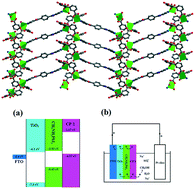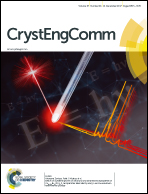Coordination polymer based perovskite device: matched energy levels and photocurrent enhancement in the absence or presence of methanol†
Abstract
Using 3,6,3′-biphenyltricarboxylic acid (H3L1) and N1,N4-di(pyridin-4-yl)terephthalamide (L), two coordination polymers (CPs) formulated as Co3L2(L1)2(H2O)8·3H2O (1) and ZnL0.5(HL1)(H2O)·2H2O (2) have been hydrothermally synthesized and structurally characterized by single-crystal X-ray diffraction. CP 2 exhibits a uninodal 3-connected two-dimensional (2D) framework with {63}-hcb topology and DFT calculation reveals that it is a semiconductor. CP 2 shows photocurrent response under visible light illumination (650 nm > λ > 350 nm). Based on CP 2, a device based on FTO/TiO2/perovskite CH3NH3PbI3/CP 2 was constructed, which yielded a much larger photocurrent density than CP 2 in aqueous electrolyte solution under visible light illumination (650 nm > λ > 350 nm), and it is ascribed to the matched valence-band maximum (VBM) and conduction-band minimum (CBM) energy levels of CP 2 and CH3NH3PbI3. In the presence of methanol, the photocurrent response generated on the device can be remarkably improved, which is due to the photoinduced holes captured by methanol, leading to the more efficient separation of the photoinduced electrons and holes.



 Please wait while we load your content...
Please wait while we load your content...